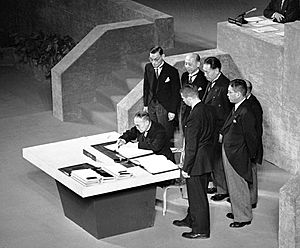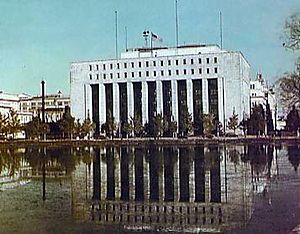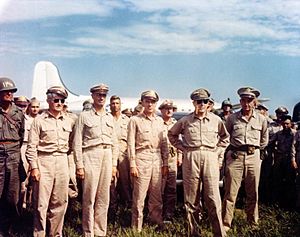Supreme Commander for the Allied Powers facts for kids
The Supreme Commander for the Allied Powers (SCAP) was the title given to General Douglas MacArthur. He led the United States-led Allied forces that occupied Japan after World War II. This position was created on August 14, 1945, when the occupation of Japan began.
In Japan, people often called SCAP "GHQ," which stood for General Headquarters. This name also referred to the offices and staff of the occupation. This staff included many US government workers and military personnel. They even helped write the first version of Japan's new Constitution. Forces from Australia, the United Kingdom, and New Zealand also worked under SCAP. They formed a group called the British Commonwealth Occupation Force.
Many Japanese people saw MacArthur as a new powerful leader, like the ancient shōgun rulers. Some historians believe that without MacArthur's leadership, Japan might not have changed from a military-led country to a democracy. MacArthur said he wanted to help the Japanese people "restore security, dignity and self-respect."
MacArthur was also in charge of southern Korea from 1945 to 1948. He ordered Lieutenant General John R. Hodge to govern that area. This led to the creation of the Republic of Korea in 1948.
Contents
General MacArthur's Role
General Douglas MacArthur is often remembered as the face of SCAP. He led Japan with a generally fair approach.
MacArthur believed that if Japan's Emperor were put on trial for war crimes, it could cause a violent uprising. He thought this would stop his main goal of changing Japan into a peaceful, democratic country. In 1946, he said that putting the Emperor on trial would need a million soldiers to keep peace.
SCAP and Japanese Leaders
SCAP and the Japanese leaders had a sometimes difficult relationship. SCAP was in charge of rebuilding Japan after the war. MacArthur focused on his work. He did not often speak directly to Japanese leaders or the public.
MacArthur and SCAP wanted to protect the Emperor from being blamed for the war. MacArthur allowed the Emperor to make statements. These statements helped make SCAP's new policies seem like a continuation of Japan's own history. This helped the Emperor keep his position. These ideas were included in the first parts of the Constitution of Japan.
Changing Japan
SCAP brought many big changes to Japan. One major change was a land reform program. This program bought about 38% of Japan's farmed land from landlords. It then sold this land to the farmers who worked on it. By 1950, most farm land was owned by the farmers themselves.
MacArthur also encouraged workers to join trade unions. This was very successful. By 1947, nearly half of all non-farm workers were in unions. SCAP also worked to break up large business groups called Zaibatsu. These groups had controlled much of Japan's industry. Later, new, looser business groups called Keiretsu formed.
Japan's old system of noble families, called kazoku, was ended by the new Japanese constitution. This system had been in place for over a thousand years. The extended royal family, called ōke and shinnōke, also lost their special rights. They became regular citizens. After the US occupation, only the Emperor and about 20 of his direct family members were still considered royalty. These changes helped transform Japan by ending the old class system.
Health and Welfare Programs
One important SCAP program was about Public Health and Welfare. It was led by US Army Colonel Crawford F. Sams. He worked with a team of 150 people. Sams helped American doctors and created new Japanese medical systems.
After the war, many Japanese people were in poor health. Doctors and medicines were hard to find. City sanitation systems were damaged by bombs. Sams' first job was to give out food from the United States. Millions of people were returning to Japan, often sick. They risked bringing diseases like smallpox and cholera. Emergency vaccinations and quarantines helped stop big outbreaks.
Sams worked with Japanese officials to build vaccine labs and improve hospitals. He also helped set up schools for doctors and nurses. He created an Institute of Public Health for training and a National Institute of Health for research.
Japan's New Constitution
One of SCAP's most important actions was writing a new Japanese constitution. MacArthur wanted to update the old Meiji constitution to make Japan a democracy. His officers wrote the new constitution in about a week.
This new constitution protected the Emperor's role as the head of state. It was approved in November 1946 and started on May 3, 1947. It is still the oldest constitution in the world that has not been changed.
Article 9
The most talked-about part of the Japanese constitution is Article 9. This part says Japan cannot go to war to settle international problems. It also says Japan cannot have a regular army.
Even with this rule, Japan has a "self-defense force" (JSDF). This force acts like a defensive military. It has about 250,000 active members. Article 9 and the JSDF are still debated in Japan today. Some people think the JSDF is against the constitution. Others want to change Article 9 so Japan can have a stronger military.
Media Control
SCAP also had strong control over all Japanese media for seven years after the war. This was done by the Civil Censorship Detachment (CCD) of SCAP. The CCD banned 31 topics from all types of media.
These banned topics included:
- Any criticism of SCAP.
- Criticism of any Allied countries.
- Any praise for "undemocratic" governments.
- Discussions about the atomic bombings of Hiroshima and Nagasaki.
- Talk about black market activities.
Some of these rules became less strict later on. But topics like the atomic bombings were not allowed to be discussed until 1952, when the occupation ended.
SCAP and the Japanese Communist Party
MacArthur allowed the Japanese Communist Party to be legal. He wanted Japan to be truly democratic. He invited them to take part in the 1946 Japanese general election. This was also the first election where women could vote.
MacArthur ordered the release of all political prisoners from the Imperial Japanese era. This included communist prisoners. He also approved the first May Day parade in 11 years in 1946. In the 1946 election, the Communist Party won only 6 seats. MacArthur's actions, like land reform, made him more popular than communism for many Japanese farmers.
SCAP's Legacy

MacArthur gave power back to the Japanese government in 1949. He stayed in Japan until President Harry S. Truman removed him from his post on April 11, 1951. General Matthew Ridgway took over as SCAP.
The San Francisco Peace Treaty was signed on September 8, 1951. It officially ended the Allied occupation. When it started on April 28, 1952, Japan became an independent country again. However, the United States continued to manage some Japanese islands, like Okinawa, until 1972.
US Military in Japan Today
Today, all parts of the United States military are still in Japan. They help defend Japan and the surrounding area. This is part of the US-Japan Mutual Security Treaty. The United States Forces Japan has about 50,000 service members. They are stationed across Japan to protect both Japanese and US interests.
Sometimes, there is tension between Japanese citizens and American service members. There are plans to move some military bases in Okinawa. This is because three-quarters of all US military bases in Japan are in Okinawa, which is a small area.
See also
- Occupation of Japan
- GI Baby
- Supreme Allied Commander Europe




